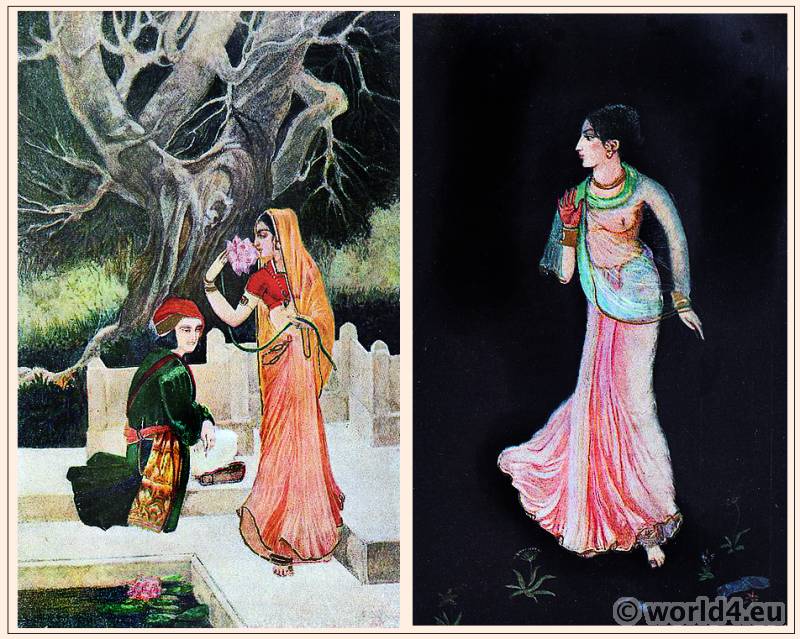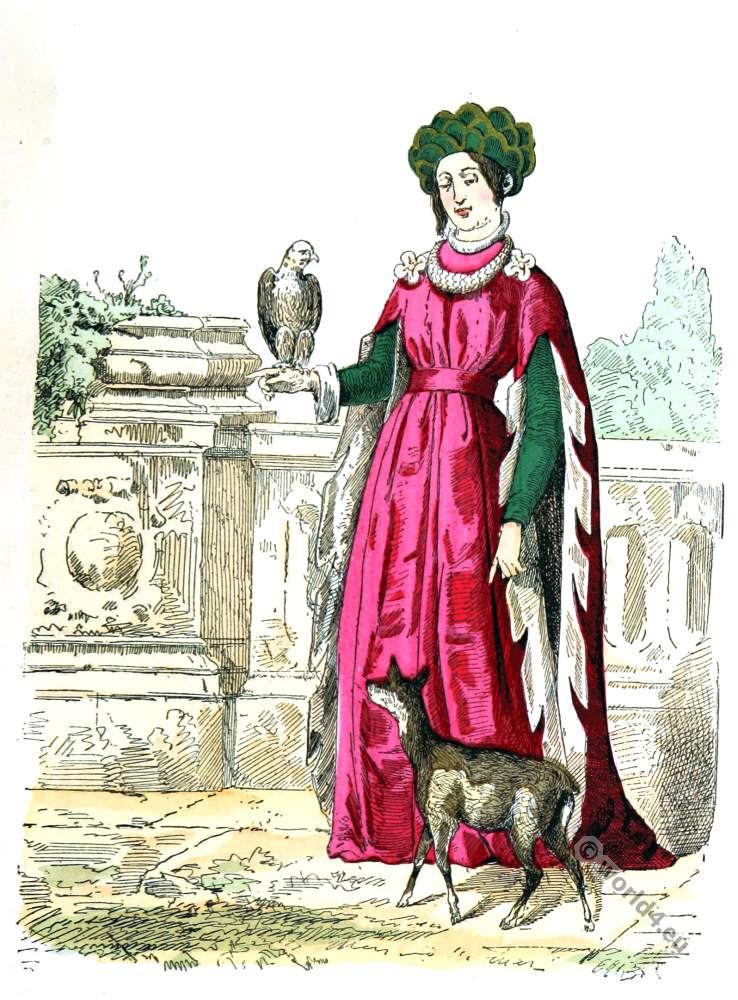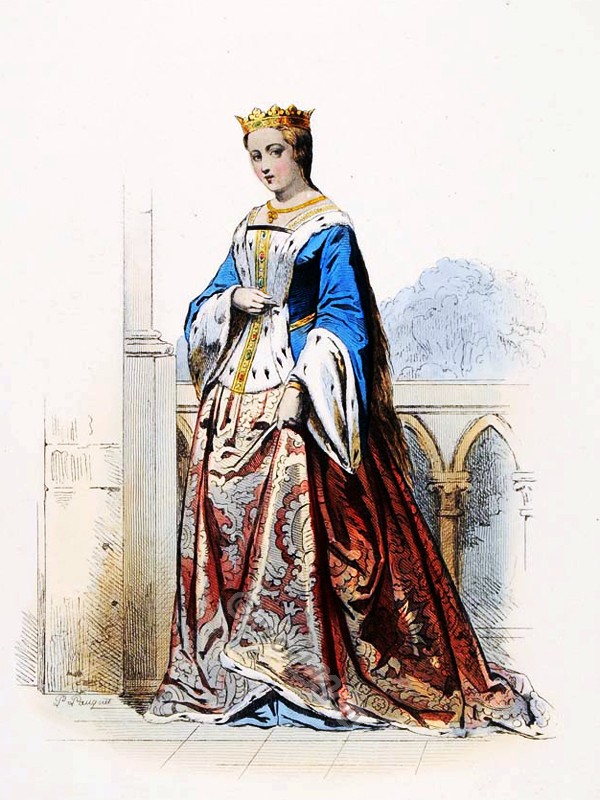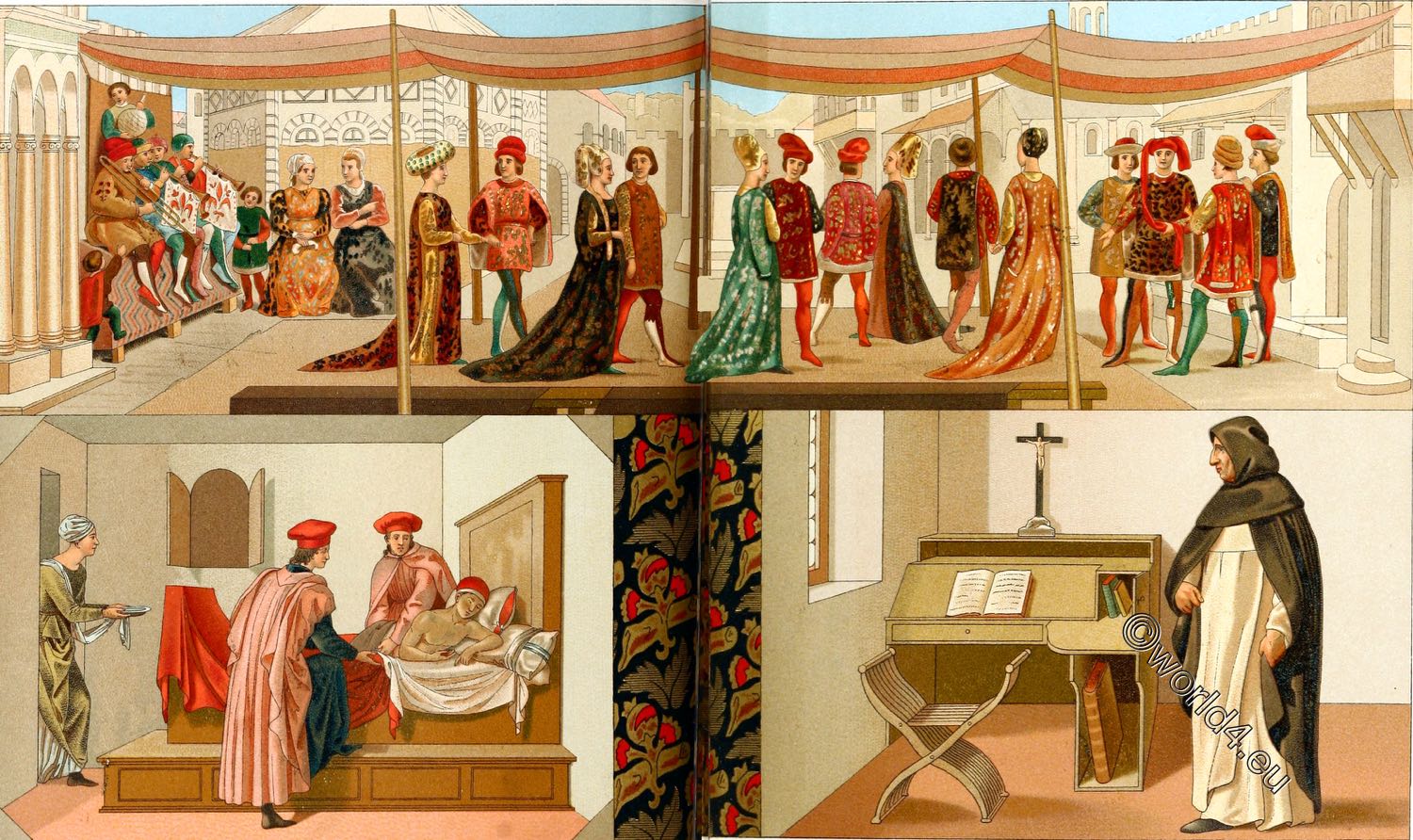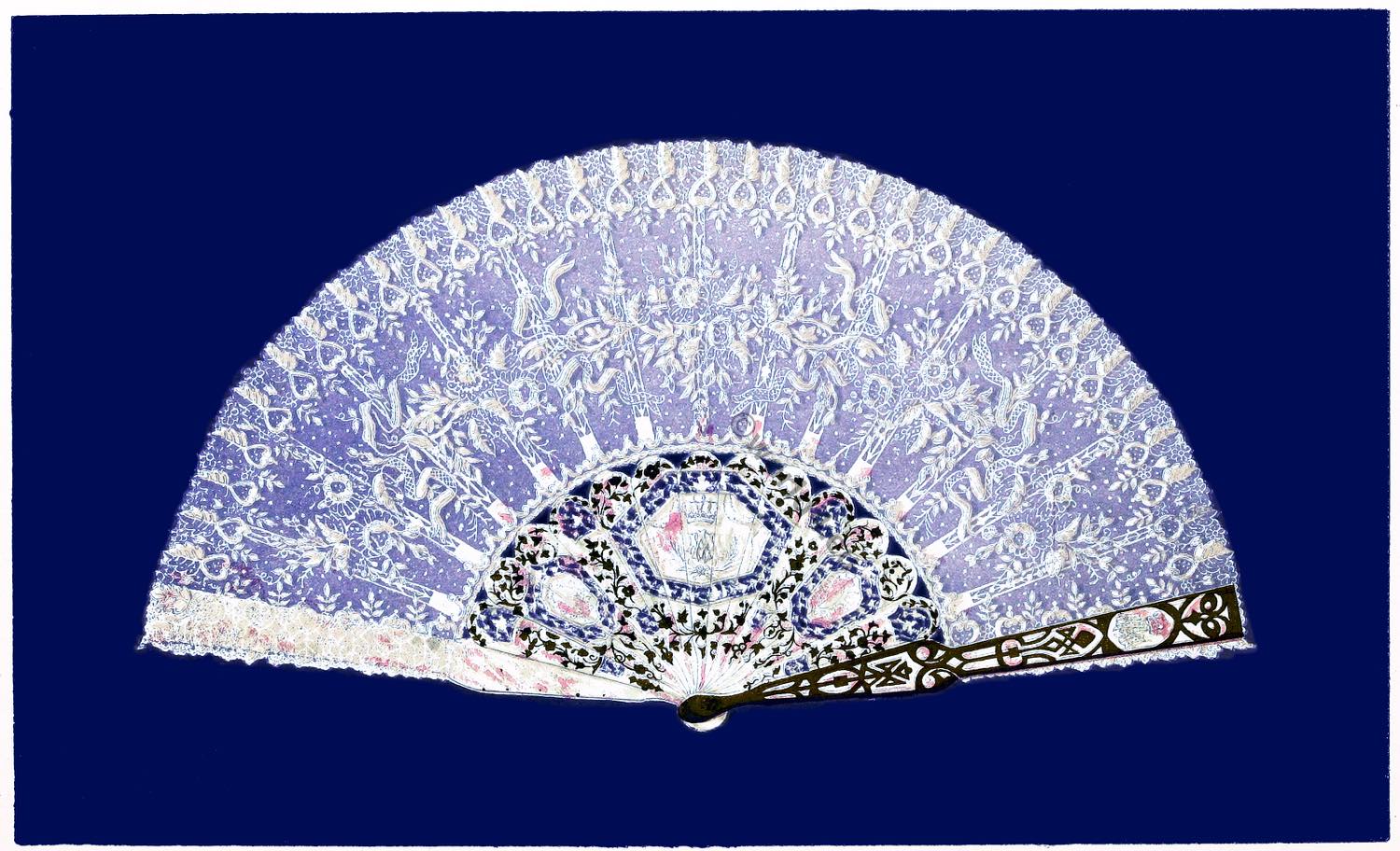
NOTES ON FANS.
Nature and Art, July 1, 1866
WE are glad to offer to our fair readers a chromolithograph and description (kindly placed at our service by Mr. W. J. Thomas, of 136, Oxford Street, one of the leading court jewelers in Europe), of a fan presented by the Princess Marie, Duchess of Hamilton, to Her Royal Highness the Princess Mary *) on the occasion of her marriage on 12 June 1866 at St Anne’s Church in the London Borough of Kew.
*) Princess Mary Adelaide of Cambridge (Mary Adelaide Wilhelmina Elizabeth; 27 November 1833 – 27 October 1897) was a member of the British royal family from the House of Hanover. She is known as the mother of Queen Mary, wife of King George V, and was one of the first members of the royal family to become involved in charitable causes
The sides are of pierced gold arabesque work, enriched with H. B. Highness’s monograms and crown in diamonds, rubies, and emeralds. The meshes are of fine carved mother-of-pearl, richly inlaid with wreaths of flowers in pure gold; the monogram and coronet carved on the centre one. The body is of the finest Brussels lace expressly designed, and the workmanship, as well as the lace of the (unbejewelled) fac simile now before us, is truly exquisite. To these particulars we take the opportunity of adding a little fan-gossip, which we hope may not prove uninteresting. To begin in the true encyclopedically style — though, by the way, as will be found on reference, the subject has not been found worth the attention of the encyclopedists — we have collected the following etymology of the word from the best authorities.
Fan. Anglo-Saxon, Fann; German and Dutch, Wanne; Italian, Vanno; French, Eventail; Spanish, Abanico; Latin, Vannus, derived (says one) from the Greek Βεντάλια meaning to “winnow, cast, or throw lightly into air.” *)
*) A very rare — perhaps unique — book exists in the Archiepiscopal library at Lambeth, dated 1578, and called “The Fanne of the Faithful.”
Certainly our Fan was never invented in a cold country. It must have been born with the sun, and have travelled westward. It has been copied from Egyptian tombs and temples, by Mr. Owen Jones, into his beautiful “Grammar of Ornament.” (Chap. III. Plate 5. Figs. 1, 4, 5, and 6.) It has turned up recently in Assyrian investigations. It may be tracked through all the painted records of Hindustan and Persia. China and Japan are full of it. Its most monstrous forms (if we except the huge steam screw-blades, now technically called fans) are the Indian Punkah, and the leaves of the Ceylon Palm, a Borassus Flabelliformis (The Palmyra Palm).
This precious tree, on which Sir Emerson Tennent thinks fully one-fourth of the population of the northern division of that island depend for sustenance, provides them with food, oil, wine, sugar, building-poles, roofs, fences, baskets, mats, books, and lastly Fans. But not from the East did the fan of society reach Britain. We owe it — according to the bulk of authority — to France. Steevens places its arrival in the reign of Henry VIII. Stow says that masks, muffs, fans, and false hair for women, were devised in Italy, and brought to England from France in 1572. That being the year of the Huguenot massacre, and of the supremacy in France of Catherine de Medici and her Italian following, it is, perhaps, not very odd that Stow should have fixed upon it for the invasion of England, by what he would have termed a pestilence of their Italian novelties. Once planted, the exotic throve apace, for in “Love’s Labour Lost,” written about 1594, we find Don Armado, “a fantastical Spaniard,” rallied for taking upon himself the office of a lady’s fan-bearer. In “Romeo and Juliet,” the nurse calls to an attendant, Peter, for her fan; and this may be taken as a satirical allusion to the frivolity of an upper class, or to a deep-seated “fan-mania” pervading all society. When Queen Bess died, her wardrobe was found to contain twenty-seven fans.
One of her Majesty’s fans, we are told by Mrs. Stone, in her “Chronicles of Fashion,” was valued at £400. Another, given to her by Sir Francis Drake, was white and red, with a gold, and jeweled handle. Even the young gallants of the time bore fans — if we may credit Greene’s “Farewell to Folly,” written in 1617. In an interesting work, called Toilette in England, by a Lady of Rank,” we find a representation of feather-fans of the Elizabethan age, bearing much resemblance to the hand fire-screens of our own time. In Mr. Fairholt’s “Costume in England,” we find numerous varieties. Several of them — an Italian one especially, shaped like a key — are of very quaint forms indeed.
In a MS., by Aubrey, “On the State of Manners in England” (dated 1671), is the following curious passage, bringing our fanology down to the reign of James I. : — “The gentlemen then had prodigious fans, with which their daughters oftentimes were corrected; Sir Edward Coke, Lord Chief Justice, rode a circuit with such a fan. Sir William Dugdale told me he was an eye-witness of it.” No. 103 of the Spectator, signed by Addison, consists of a most amusing “letter to the Editor,” as we should say now- a-days, upon “The exercise of the fan.” “Women,” says the supposed correspondent, “are armed with fans, as men with swords, and sometimes do more with them.” “To the end, therefore, that ladies may be entire mistresses of the weapon which they bear, I have erected an academy for the training up of young women in the exercise of the fan, according to the most fashionable airs and notions that are now practiced at Court.” Having set out a scheme of fan-drill and evolutions, the author dilates upon their philosophy and poetry, most amusingly. He attaches most importance to “the flutter,” which “masterpiece of the exercise may be learnt,” he says, “in three months and he believes that by attention and observation, a “woman of tolerable genius, who will apply herself diligently for one half-year, shall be able to give her fan all the graces that can possibly enter into that little modish machine.”
The fan, too, like the garter, has been the base of an order of chivalry. Louisa Ulrica, Queen of Sweden, instituted in 1744, the Order of the Fan for the ladies, of her court; and gentlemen were afterwards allowed to join it. Fan-making must have been a brisk business in England some years earlier; for we find that the Worshipful Company of Fan-makers of London, the eighty-fourth in order of precedence of the Civic guilds, was incorporated in 1709; and was well enough reputed to attract to its fellowship good men and true from outside the City walls. With the foundation of the Fan-makers’ Company ends the archaeology of the English fan, which thenceforward became part and parcel of our everyday life.
For just a century after Addison wrote, the fan figured prominently in polite society, matched, when the sword went out of fashion, against the snuff-box and the clouded cane, and often victorious. The satirists and dramatists were in turn bitter and pleasant in their references to it.
Painters and their sitters paraded it ostentatiously. It is said to have done wonders in diplomacy, and who could wonder at the success of flying sap and masked battery against garrisons defended by an eye-glass, a pinch of snuff, and a malacca. The fan’s apogee was in the days of the minuet de la cour. But since athletic waltzes, piolkas, and mazurkas have elbowed out their courtly predecessors, the once “modish little machine” has retired into obscurity with the “wall-flowers,” or, if at all, is used by the dancers as inartistically as though it were the archetypal “vanne” or wind engine.
Brighter days may, however, dawn, and society which, in its way back to costumes of the Watteau and Pastoral periods, has already reached the stage of short waists and long trains, may even in our time reclaim the little exile from its temporary partial shade. We have not time to trace or follow its career in other lands.
Though many may perhaps wish we had illustrated its best-known, or Spanish variety, we must needs leave that field for some more erudite students of costume, and conclude by devoutly rejoicing that, in the ordinary fan of the present day Art has not strayed far from Nature. To Nature we owe the Palmyra, the Borassus, and the Talipat; to Art, the beautiful productions of which our illustration depicts an example.
Source: Nature and art. London: Day & Son, 1866-1867.
Related
Discover more from World4 Costume Culture History
Subscribe to get the latest posts sent to your email.

